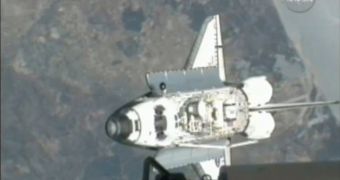After spending about two days chasing the International Space Station (ISS) in Earth's orbit, the space shuttle Atlantis finally managed to catch up with the lab Sunday, May 16. The spacecraft docked on the facility at 10:28 am EDT (1428 GMT), after performing the back flip maneuver that has now become standard practice. Its purpose is to expose orbiters' underbellies to ISS crew members, which can then snap photos of their heat shields, and send them back to Mission Control for analysis. The new mission is scheduled to last for 12 days, and will most likely include three spacewalks, Space reports.
The hatch between the two spacecrafts were opened at 12:18 pm EDT (1618 GMT), when the Atlantis crew doubled the population on the ISS. Twelve people now revolve in Earth's orbit at the same time. “It's bigger than when we remember and, speaking for myself, better than we remember. I love this place,” said after opening of the hatches Ken Ham, who is the Commander of the last Atlantis flight. He visited the orbital facility in the past, most recently back in 2008. He also said that the shuttle crew was amazed to see how brightly the ISS was shining from the outside. “It is an absolutely stunning view,” the NASA astronaut added.
Atlantis' main payload for this mission is the Russian-built Mini Research Module-1, called Rassvet. The new compartment will play a dual role, as it will be used both for storing various cargo, and as a docking port/airlock. For the trip to orbit, mission planners made the best of the $200 million module, and loaded it up with some 3,000 pounds (1,400 kilograms) of cargo. This included spare parts for various systems on the station, new laptops for the crew, food, science experiments and other supplies. In addition to the MRM-1, another container is carrying spare parts for the ISS' robotic arm, as well as a new set of solar array batteries.
The first extra-vehicular activity (EVA) will take place today, when spacewalkers will install a spare space-to-ground Ku-band antenna on the station's truss structure. The Rassvet module is planned for ISS attachment on Tuesday. During the third and final spacewalk, astronauts will replace solar batteries and move the spent ones inside the same cargo carrier module the new ones were brought up in. This is Atlantis' final mission, according to the current NASA flight manifest. After the shuttle returns to the Kennedy Space Center (KSC), only two other flights, by Discovery and Endeavor, will be carried out before the space agency retires its shuttle fleet.

 14 DAY TRIAL //
14 DAY TRIAL //